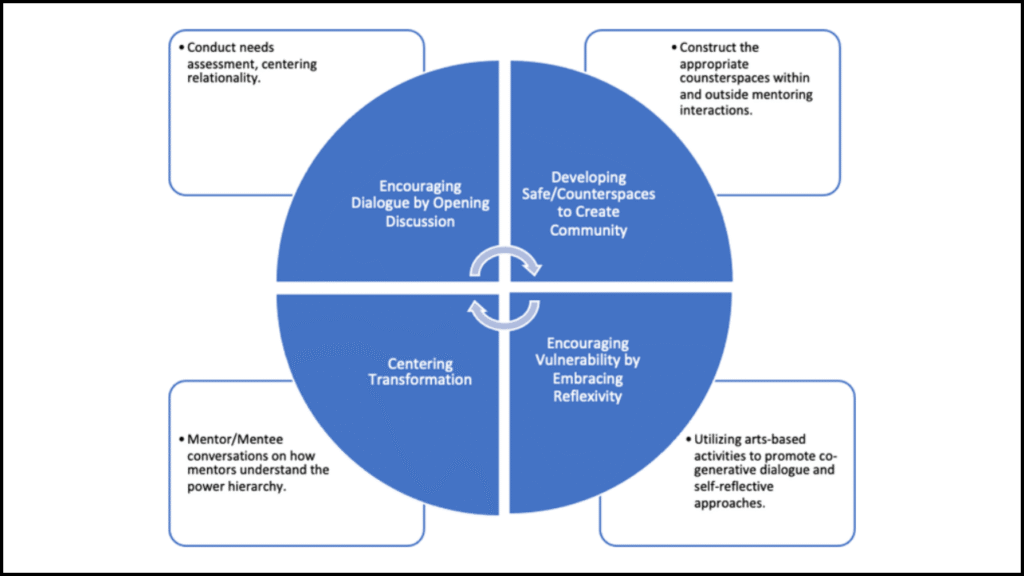
Scientific identity represents the way students see themselves as part of the scientific community. STEM students often face challenges in building this identity because they must navigate both technical skills and cultural expectations of science. Mentoring plays a vital role by shaping self-confidence, creating belonging, and opening career pathways. A structured mentor-mentee relationship gives students tools to view themselves not just as learners but as contributors to knowledge.
Table of Contents
Overview
| Dimension | Impact of Mentoring on Scientific Identity |
|---|---|
| Confidence | Strengthens belief in scientific ability through guidance and recognition. |
| Belonging | Connects students with peers, labs, and wider research communities. |
| Role Modeling | Provides examples of successful scientists to emulate. |
| Skill Building | Develops research, analysis, and communication competencies. |
| Career Growth | Offers direction for internships, projects, and higher studies. |
| Motivation | Sustains persistence in the face of academic challenges. |
| Identity Validation | Confirms that students can meaningfully contribute to STEM. |
Mentoring as a Foundation of Scientific Identity
- Development of Self-Concept
- Students begin to see themselves as capable scientists when mentors validate their progress.
- Encouragement after research challenges reinforces self-concept.
- Integration into Scientific Culture
- Mentors introduce lab norms, research ethics, and publication practices.
- Scientific identity becomes stronger when students understand the cultural values of STEM.
- Retention in STEM Pathways
- Students without mentors often feel disconnected and may leave STEM fields.
- Mentorship fosters persistence by making students feel part of a supportive ecosystem.
Key Benefits of Mentoring for STEM Students
1. Confidence and Competence
- Mentors provide constructive feedback that strengthens technical confidence.
- Research discussions allow mentees to apply theory in practice, boosting competence.
- Failure is reframed as part of scientific growth rather than a personal weakness.
2. Sense of Belonging
- Regular mentor interaction reduces isolation in competitive STEM environments.
- Peer mentoring groups create solidarity among students facing similar hurdles.
- Belonging enhances commitment to pursue advanced research or careers in science.
3. Role Modeling and Inspiration
- Mentors embody successful scientific careers, showing mentees what is achievable in their futures.
- Observing mentors’ resilience during challenges inspires perseverance.
- Shared backgrounds between mentors and mentees build stronger identification.
4. Skill Development
- Technical guidance helps students master laboratory methods, programming, or fieldwork.
- Professional communication, paper writing, and presentation skills grow under mentoring.
- Critical thinking and problem-solving are modeled through mentor-led discussions.
5. Career Guidance
- Mentors guide applications for internships, fellowships, and graduate school.
- Networking opportunities connect students with conferences and professional bodies.
- Career uncertainties reduce as mentors provide clarity on possible pathways.
Comparison: With vs Without Mentoring
| Factor | With Mentoring | Without Mentoring |
|---|---|---|
| Confidence | High self-belief and resilience | Low confidence, fear of failure |
| Belonging | Strong connection to the STEM community | Feelings of isolation |
| Skills | Research and communication competencies | Limited exposure and guidance |
| Career Growth | Clear pathways and opportunities | Uncertainty and limited direction |
| Motivation | Sustained through challenges | Decline during setbacks |
| Identity Formation | Strong, validated scientific self-concept | Weak or fragmented identity |
Challenges in Mentoring Relationships
- Mismatch in Expectations
- Students may seek personal guidance, while mentors focus only on technical advice.
- Accessibility Issues
- Busy academic schedules can limit the availability of mentors.
- Bias and Representation
- Lack of diverse mentors sometimes prevents students from fully identifying with them.
- Communication Gaps
- Misunderstandings in expectations can limit the effectiveness of mentoring.
Strategies to Strengthen Mentorship Impact
- Structured Programs
- Institutions can design mentorship initiatives with clear goals and responsibilities.
- Training for Mentors
- Faculty can receive guidance on providing inclusive and supportive mentoring.
- Peer and Near-Peer Mentoring
- Senior students can mentor juniors, extending the mentoring chain.
- Recognition of Mentorship
- Universities can value and reward mentoring as part of academic service.
Long-Term Effects of Mentoring on STEM Identity
- Strong mentoring relationships increase the number of students pursuing advanced degrees.
- Underrepresented groups gain confidence to continue in fields where they are minorities.
- Professional identity becomes stable as students transition from learners to contributors.
- Research communities benefit from diverse perspectives nurtured by inclusive mentoring.
Extended Impact
| Long-Term Area | Effect of Mentoring |
|---|---|
| Graduate Studies | Increased enrollment and completion rates |
| Research Productivity | Higher participation in projects, publications, and conferences |
| Workplace Integration | Smoother transition from academic to professional roles |
| Innovation | Broader contributions due to diverse perspectives |
| STEM Retention | Reduction in dropout rates across underrepresented groups |
Parting Insights
Mentoring shapes scientific identity by validating student potential, nurturing skills, and embedding them in the culture of science. A supportive mentor relationship ensures that STEM students see themselves not as outsiders but as capable members of the scientific community. Strong mentoring not only transforms individual journeys but also strengthens the scientific field by creating confident, skilled, and motivated professionals.





